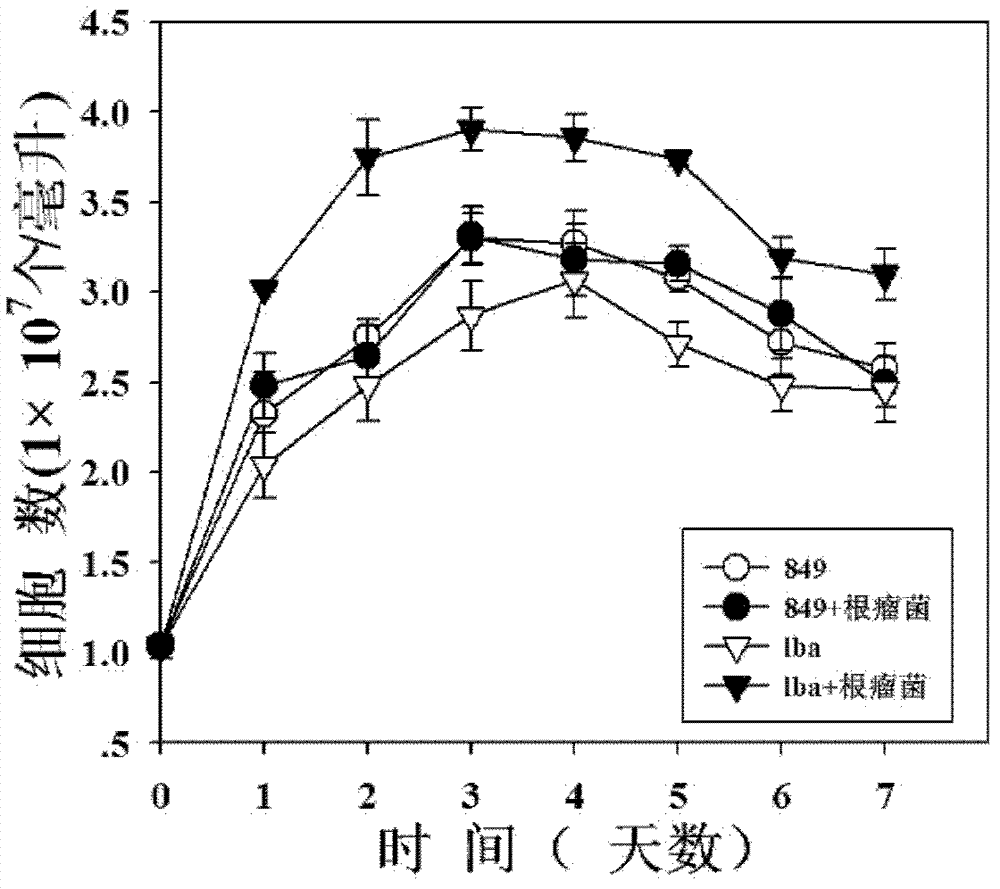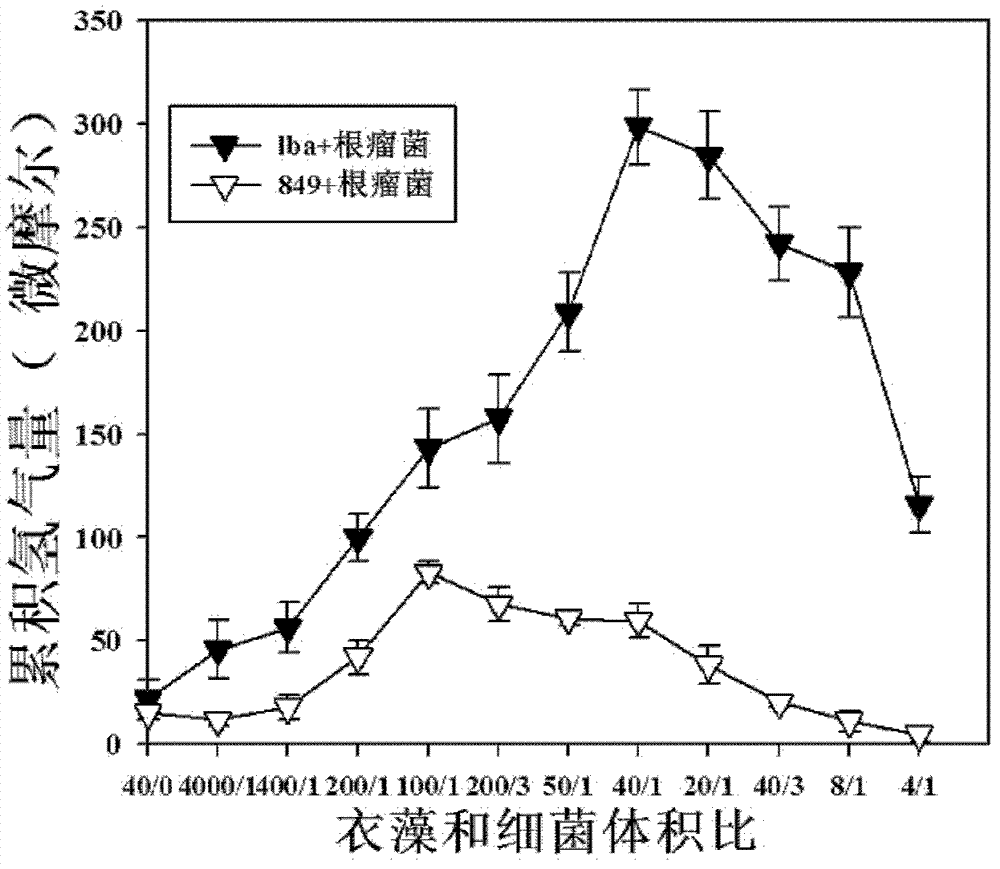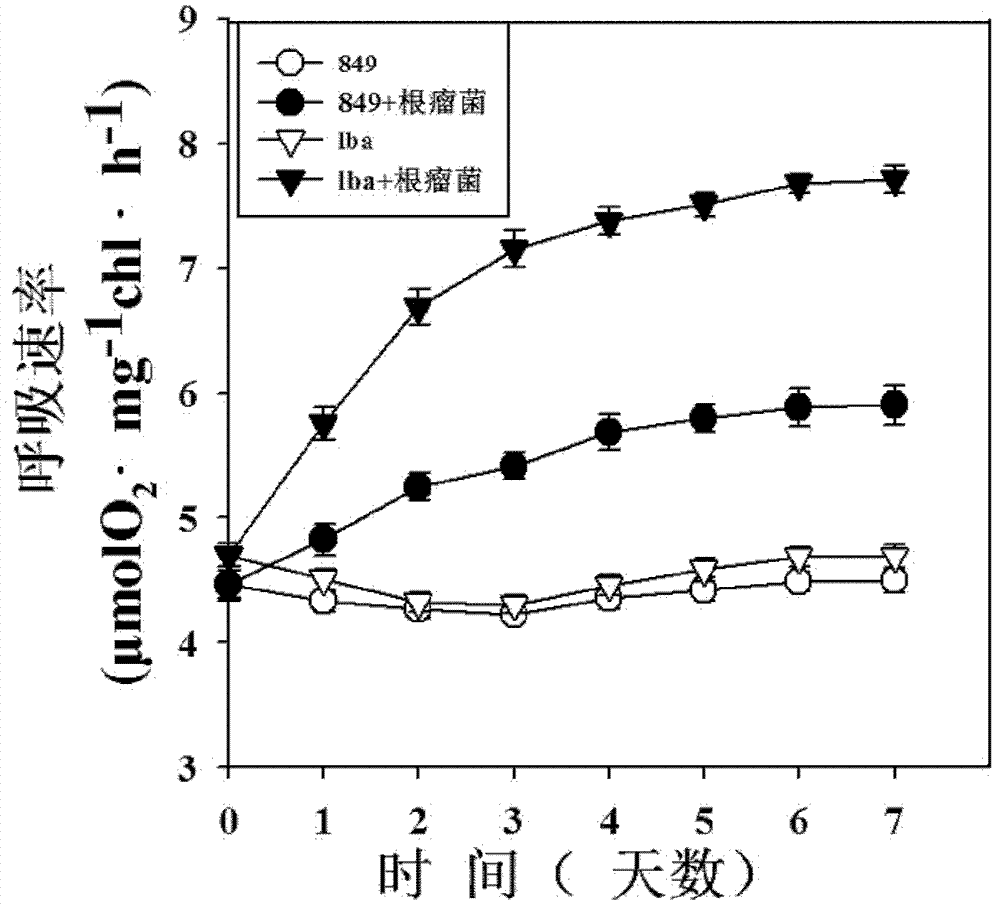Method for increasing hydrogen yield of Chlamydomonas reinhardtii by using slow-growing Bradyrhizobium japomcum
A technology of soybean rhizobia and rhinoceros is applied in the field of biological hydrogen production, which can solve problems such as inability to meet industrial production.
- Summary
- Abstract
- Description
- Claims
- Application Information
AI Technical Summary
Problems solved by technology
Method used
Image
Examples
Embodiment 1
[0043] The growth situation of rhizobia co-cultured with cc849 and lba under the normal conditions of embodiment 1
[0044] In the first stage of the two-step hydrogen production technology, in order to study the influence of rhizobia on the growth of Chlamydomonas, rhizobia were mixed with Chlamydomonas reinhardtii cc849 and transgenic algae lba in normal TAP according to the volume ratio of 2ml:30ml. In the medium, the pure cc849 and lba were used as controls respectively, and the number of algae cells in the culture medium was detected every day (such as figure 1 shown), the results showed that when cc849 and lba were co-cultured with rhizobia, the time dynamic trend of their growth was similar to that of cc849 and lba when they were cultured alone: the algal cells entered the logarithmic growth phase on the first day of culture, and in the It reaches saturation in about 3-4 days, and then tends to be stable. However, the number of algal cells co-cultured with rhizobia a...
Embodiment 2
[0045] The effect of rhizobia on the hydrogen production of cc849 and lba under the condition of hydrogen production in the absence of sulfur in Example 2
[0046] In the second stage of the two-step hydrogen production technology, rhizobia were mixed with cc849 and lba in sulfur-deficient medium according to different volume ratios for co-culture, and pure cc849 and lba were cultured separately as controls, and hydrogen production was continuously detected Quantitative differences (such as figure 2 shown). From figure 2 It can be seen that rhizobia significantly promoted the accumulation of hydrogen production of cc849 and lba, and the promoting effect was related to the volume ratio of algal bacteria. When the concentration of rhizobia is OD 600 When the cell concentration of =1, cc849 and lba was 12.5mg chlorophyll / L, rhizobia was in algae liquid: when bacterium liquid (volume ratio) was 40: 1, promptly added 1mL bacterium liquid in 40mL algae liquid, the production of...
Embodiment 3
[0047] Photosynthetic oxygen release and respiratory oxygen consumption of the co-culture system of embodiment 3 algae
[0048] In normal TAP medium, the effects of co-cultivation of rhizobia with cc849 and lba on photosynthetic oxygen evolution and respiration oxygen consumption in the system were detected by oxygen electrode method. The results showed that no photosynthetic oxygen evolution could be detected when rhizobia were co-cultured with Chlamydomonas cc849 and lba, only respiratory oxygen consumption (such as image 3 shown). In the first 3 days of 7-day continuous culture, the respiration rate of cc849 and lba cultured alone showed a gradual downward trend, and reached the lowest on the third day, about 4.22-4.30 μmol O 2 .mg -1 chl.h -1 , and then rebounded slightly, but basically stable at 4.46-4.70 μmol O 2 .mg -1 chl.h -1 between. When cc849 and lba were co-cultured with rhizobia respectively, the respiration rate of the system showed a rising trend, and w...
PUM
 Login to View More
Login to View More Abstract
Description
Claims
Application Information
 Login to View More
Login to View More - R&D
- Intellectual Property
- Life Sciences
- Materials
- Tech Scout
- Unparalleled Data Quality
- Higher Quality Content
- 60% Fewer Hallucinations
Browse by: Latest US Patents, China's latest patents, Technical Efficacy Thesaurus, Application Domain, Technology Topic, Popular Technical Reports.
© 2025 PatSnap. All rights reserved.Legal|Privacy policy|Modern Slavery Act Transparency Statement|Sitemap|About US| Contact US: help@patsnap.com



